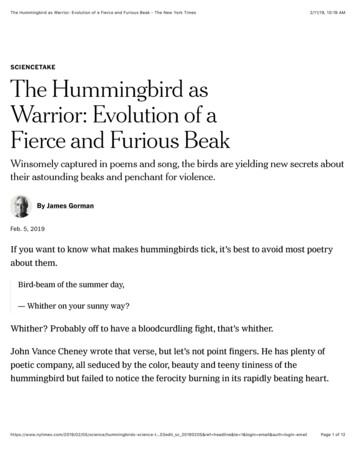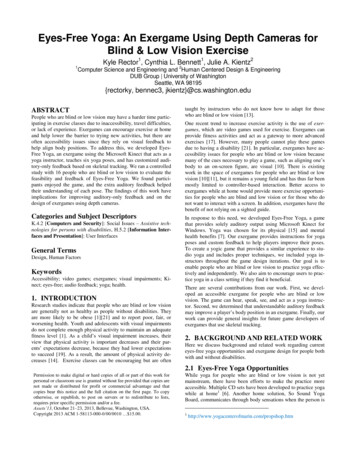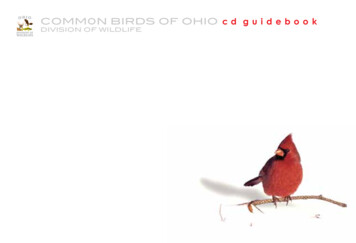
Transcription
The Hummingbird as Warrior: Evolution of a Fierce and Furious Beak - The New York Times2/11/19, 10(19 AMSCIENCETAKEThe Hummingbird asWarrior: Evolution of aFierce and Furious BeakWinsomely captured in poems and song, the birds are yielding new secrets abouttheir astounding beaks and penchant for violence.By James GormanFeb. 5, 2019If you want to know what makes hummingbirds tick, it’s best to avoid most poetryabout them.Bird-beam of the summer day,— Whither on your sunny way?Whither? Probably off to have a bloodcurdling fight, that’s whither.John Vance Cheney wrote that verse, but let’s not point fingers. He has plenty ofpoetic company, all seduced by the color, beauty and teeny tininess of thehummingbird but failed to notice the ferocity burning in its rapidly beating ummingbirds-science-t 03edit sc 20190205&ref headline&te 1&login email&auth login-emailPage 1 of 12
The Hummingbird as Warrior: Evolution of a Fierce and Furious Beak - The New York Times2/11/19, 10(19 AMThe Aztecs weren’t fooled. Their god of war, Huitzilopochtli, was a hummingbird. TheAztecs loved war, and they loved the beauty of the birds as well. It seems they didn’tfind any contradiction in the marriage of beauty and bloodthirsty aggression.Scientists understood that aggression was a deep and pervasive part ofhummingbird life. But they, too, have had their blind spots. The seemingly perfectmatch of nectar-bearing flowers to slender nectar-sipping beaks clearly showed thathummingbirds were shaped by co-evolution.It seemed clear that, evolutionarily, plants were in charge. Their need for reliablepollinators produced flowers with a shape that demanded a long slender bill.Hummingbird evolution obliged.But hummingbirds also heard the call of battle, which demanded a differentevolutionary course. Some of those slender, delicate beaks have been reshaped intostrong, sharp and dangerous weapons.In a recent paper organizing and summing up 10 years of research, Alejandro RicoGuevara and his colleagues at the University of California, Berkeley, shared evidencegathered by high-speed video about how the deadly beaks are deployed in male-tomale conflict.Like the horns of bighorn sheep or the giant mandibles of stag beetles, hummingbirdbeaks are used to fight off rivals for mates. This is sexual selection, a narrow part ofnatural selection, in which the improvement of mating chances is the dominant force.The males use their bills to stab other males, and to fence — feinting and parrying,sometimes knocking the other bird off a perch. Some hummingbirds even havehooked beaks, with serrations that look like shark’s teeth. Dr. Rico-Guevara’s highspeed video shows males tearing out another bird’s feathers with those e/hummingbirds-science-t 03edit sc 20190205&ref headline&te 1&login email&auth login-emailPage 2 of 12
The Hummingbird as Warrior: Evolution of a Fierce and Furious Beak - The New York Times2/11/19, 10(19 AMThe beak of a male tooth-billed hummingbird, found in the forests of Colombia, isadapted for battle. Kristiina HurmeThis is only one of several findings by Dr. Rico-Guevara and others that haverecently changed the way hummingbirds are understood, including the unusual waythey process sugar, the way they use their tongues in nectar drinking, and theevolution of bill shape.[Like the Science Times page on Facebook. Sign up for the Science Timesnewsletter.]Douglas Altshuler, an ornithologist at the University of British Columbia, inVancouver, said that Dr. Rico-Guevara’s thoroughness and attention to detail havepushed research on hummingbirds to new levels of excellence. “I think the body ofwork is great,” he mmingbirds-science-t 03edit sc 20190205&ref headline&te 1&login email&auth login-emailPage 3 of 12
The Hummingbird as Warrior: Evolution of a Fierce and Furious Beak - The New York Times2/11/19, 10(19 AMRichard Prum, an ornithologist at Yale who studies the kind of evolution thatproduces extreme male characteristics, described the research as spectacular:“Love this guy, love his work.”Dr. Rico-Guevara began his study of hummingbirds as an undergraduate at theNational University of Colombia. His adviser was Gary Stiles, a leading expert onhummingbirds, under whose tutelage Dr. Rico-Guevara wrote an honors thesis onhow hummingbirds hunt insects to supplement their diet of nectar, which is puresugar.At about the same time, Margaret A. Rubega, an evolutionary biologist at theUniversity of Connecticut, published a paper in Nature on the way hummingbirdsbend their bills to capture insects. One thing led to another, and Dr. Rico-Guevaraended up at UConn, doing his Ph.D. research with Dr. Rubega on /05/science/hummingbirds-science-t 03edit sc 20190205&ref headline&te 1&login email&auth login-emailPage 4 of 12
The Hummingbird as Warrior: Evolution of a Fierce and Furious Beak - The New York Times2/11/19, 10(19 AMAlejandro Rico-Guevara, an expert on hummingbirds, at the University of California, Berkeley, left; and anAnna's hummingbird at a feeder at Dr. Rico-Guevara's house. Peter Prato for The New York TimesThe research on hummingbird tongues was groundbreaking. The dominant ideaabout how the birds suck up nectar was that the shape of the beak and the tongueproduced capillary action, in which liquid rises against gravity because ofmechanical hummingbirds-science-t 03edit sc 20190205&ref headline&te 1&login email&auth login-emailPage 5 of 12
The Hummingbird as Warrior: Evolution of a Fierce and Furious Beak - The New York Times2/11/19, 10(19 AMThis is what happens when a narrow tube is inserted into liquid, or when a brushsoaks up paint even though only the tip is in the liquid.Dr. Rico-Guevara and Dr. Rubega showed instead that the hummingbird’s feedingmethod was completely different: As the forked tip of its tongue is withdrawn up thenarrow bill, it traps nectar.All hummingbirds fight, including females, but only a few species have weaponizedbills. Dr. Rico-Guevara found that males wage their battles to claim the best matingterritories.In some species, males assemble in areas called leks, away from the flowers thatthey feed on. In a lek, each male has a territory, and the females shop around.The territories vary quite a lot in size, but about 270 square feet is typical — the sizeof a very small New York City apartment. Central territories are the most prized, anda swordlike bill helps a male capture and keep that prime real estate.In other hummingbird species with weaponized beaks, males set up matingterritories right on the richest patches of flowers, again fighting off rivals. For them,Dr. Rico Guevara said, it doesn’t really matter if they aren’t the most efficient nectardrinkers — “just don’t let anybody else get to the flower.”Extremists with wingsHummingbird research is a rich, growing field, delving into everything fromaerodynamics to how the birds process sucrose.“In things that you can measure in any animal, like metabolism, they’re extreme,”said Dr. Altshuler. “Another way they’re extreme is in terms of their 05/science/hummingbirds-science-t 03edit sc 20190205&ref headline&te 1&login email&auth login-emailPage 6 of 12
The Hummingbird as Warrior: Evolution of a Fierce and Furious Beak - The New York Times2/11/19, 10(19 AMHummingbirds also offer “opportunities to explore the limits of physiology,” Dr. RicoGuevara said. They have the highest metabolic rate among vertebrates, and theyspecialize in hovering, “the most expensive form of locomotion in nature.”Hovering, coincidentally, is a form of flight that is of intense interest to the designersof flying robots. “Everybody wants to replicate hummingbird flight,” he said.The birds are also great to use in experiments, said Chris Clark, a biologist at theUniversity of California, Riverside, who has collaborated with Dr. Rico-Guevara instudies of hummingbird flight.The birds will fly readily to feeders. The presence of humans does not put them off.And, “they fly really well in wind tunnels and e/hummingbirds-science-t 03edit sc 20190205&ref headline&te 1&login email&auth login-emailPage 7 of 12
The Hummingbird as Warrior: Evolution of a Fierce and Furious Beak - The New York Times2/11/19, 10(19 AMPosters on the wall of the flight lab in Dr. Rico-Guevara's lab, left, and a male saw-billed hermithummingbird, whose forked tongue is visible. Peter Prato for The New York Times, left; Kristiina mmingbirds-science-t 03edit sc 20190205&ref headline&te 1&login email&auth login-emailPage 8 of 12
The Hummingbird as Warrior: Evolution of a Fierce and Furious Beak - The New York Times2/11/19, 10(19 AMHummingbird behavior is also of interest because they have been shown to beexcellent learners. Dr. Clark said there is speculation that because they live on theedge in terms of their energy budget, they may require a great memory for wherethe food sources are.In listing multiple areas of interest for studying hummingbirds, Dr. Rico-Guevaraconceded that he’s attracted to them for another reason.“What has kept me attached to them is their incredible personality,” he said. “Theyare very bold. They come to you to explore what you are doing. They are inquisitive.”He can only hope that in his science, “My curiosity would match their curiosity.”And he does have some poetic company. Not all poets got stuck on the beauty of thebirds. D.H. Lawrence, in “Humming-Bird” imagines an ancient one at the dawn ofcreation.Probably he was bigAs mosses, and little lizards, they say, were once big.Probably he was a jabbing, terrifying /hummingbirds-science-t 03edit sc 20190205&ref headline&te 1&login email&auth login-emailPage 9 of 12
The Hummingbird as Warrior: Evolution of a Fierce and Furious Beak - The New York Times2/11/19, 10(19 AMA black-throated mango and a lesser violetear doing battle at Finca el Colibrí Gorriazul, a coffee farm inColombia. Christian IrianEarlier reporting about ence/hummingbirds-science-t 3edit sc 20190205&ref headline&te 1&login email&auth login-emailPage 10 of 12
The Hummingbird as Warrior: Evolution of a Fierce and Furious Beak - The New York TimesThe Amazing Metabolism of HummingbirdsThe Hummingbird’s Tongue: How It WorksSCIENCE2/11/19, 10(19 AMMarch 20, 2018Sept. 8, 2015SCIENCE The Hummingbird as Warrior: Evolution of a Fi Hand-Feeding Hummingbirds: You Can Do It, but Should You?Sept. 8, 2018Saving Hummingbirds Is One Small Step in Saving the PlanetSept. 21, 2018Correction: Feb. 5, 2019A picture credit on an earlier version of this article, using information provided by asource, misspelled the given name of a photographer. He is Christian Irian, notCristian.James Gorman is a science writer at large and the host and writer of the videoseries “ScienceTake.” He joined The Times in 1993 and is the author of several books,including “How to Build a Dinosaur,” written with the paleontologist Jack Horner.A version of this article appears in print on Feb. 4, 2019, on Page D1 of the New York edition with the headline: So Fast, So ummingbirds-science-t 3edit sc 20190205&ref headline&te 1&login email&auth login-emailPage 11 of 12
The Hummingbird as Warrior: Evolution of a Fierce and Furious Beak - The New York Times2/11/19, 10(19 AMREAD 24 /hummingbirds-science-t 3edit sc 20190205&ref headline&te 1&login email&auth login-emailPage 12 of 12
how hummingbirds hunt insects to supplement their diet of nectar, which is pure sugar. At about the same time, Margaret A. Rubega, an evolutionary biologist at the University of Connecticut, published a paper in Nature on the way hummingbirds bend their bills to capture insects. One thing led to another, and Dr. Rico-Guevara










